In this article, we would see an in-depth comparison of SEMrush vs Moz Pro. We would find out which SEO tool offers the best features for your business.
We would be using the following features to compare both tools:
- Backlink analysis/building
- Domain analysis
- Keyword research
- Traffic analytics
- SERP tracking
- Site audit
- Broken link building
….and more!
Before we get started with the comparison, let’s briefly introduce both tools.
What are SEMrush and Moz Pro?
SEMrush
SEMrush is an all-in-one marketing solution for improving online visibility and discovering actionable marketing insights. The tool offers marketers with solutions for SEO, keyword research, PPC, SMM, Content Marketing, Competitive Research, Campaign Management, PR, and Marketing Insights.
The SEO tool comes with features that meet the needs of small, medium, and large businesses. With this tool, you can easily track the keywords your competitors are ranking for, run an SEO audit for your blog, manage PPC Campaigns, look for backlinking opportunities, and much more.
Moz Pro
Moz Pro Is an all-in-one SEO software that helps individuals to run successful SEO campaigns. The platform helps businesses handle several aspects of their SEO campaigns from audience analysis, track site rankings, site crawler, page optimization, link building opportunities, and more.
Now that we have introduced both tools, let’s compare the features offered by both of them.
We would start with domain analysis.
Domain Analysis
In this category, we would compare both tools using their domain analysis features.
| DOMAIN ANALYSIS | SEMrush | Moz |
| Competitive positioning map | Yes | No |
| Estimated monthly traffic | Yes | No |
| Number of domains for side to side comparison | up to 5 | up to 3 on the entry plan |
| Mobile SERP ranking | Yes | Yes |
SEMrush
SEMrush comes with a domain overview tool that gives you a quick overview of a domain’s overall search presence. You get insight into metrics like the domain’s authority score, the estimated number of traffic the website receives from organic search monthly, the amount of estimated traffic the website receives from PPC ads, the total number of backlinks going to the domain, and the number of display ads that the domain runs through Google AdSense.

There is also a Keywords by Countrywidget that shows you where most of your traffic is coming from – for both paid and organic searches. You can also adjust your analytics report by device – mobile or desktop.
There is also a Traffic trendfeature that details how much-estimated traffic went through your domain over a period of time.
With the Keyword Gap tool I mentioned earlier, you can compare all of your metrics with up to 5 competitors.
With SEMrush’s domain overview, you get metrics that cover everything about your domain traffic. This would include:
For organic search:top organic keywords, organic position distribution, main organic competitors, competitive positioning map (organic), branded traffic trend, and branded vs non-branded traffic.
For paid search:top paid keywords, paid position distribution, main paid competitors, competitive positioning map (paid), and sample text ads.
Along with showing reports on a domain’s backlink profile, the domain overview tool shows display advertising data. This would give you all the details on how your competitors use online display ads.
Moz Pro
Moz also has a Domain SEO analysis toolthat is similar to SEMrush’s overview tool. When you research a domain, you would also see similar metrics like an authority score, number of external links pointing to the website, the number of keywords the website ranks for, and competitive keywords.
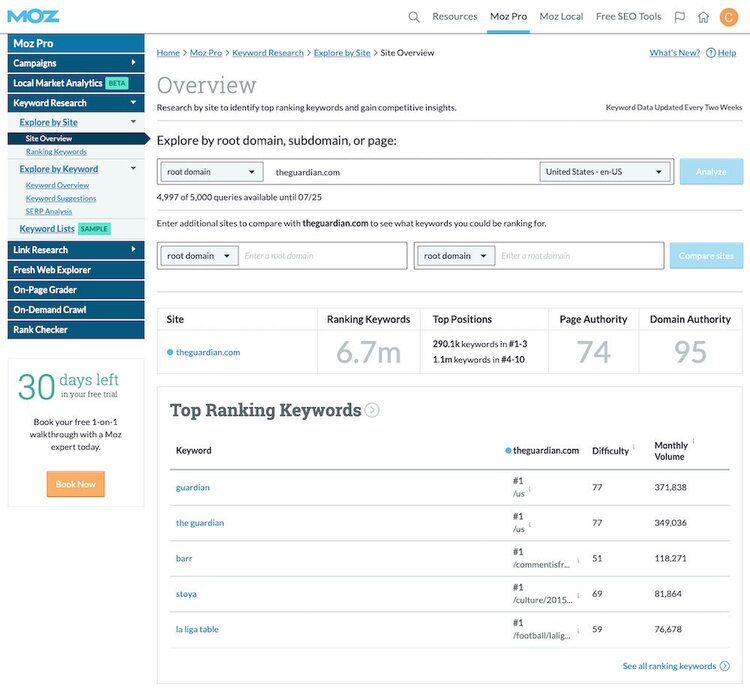
Performing domain analysis on SEMrush is straightforward in the Domain Overview section.
In Moz however, the process isn’t as straightforward. Moz domain analysis tool divides domain analysis reports into two sections – keyword research and link research. So, to get all the data you need, you would need to toggle between both sections.
Compared to SEMrush’s domain analysis tool where you see keyword data, link data, and other important metrics at once, you would need to set up a campaign in Moz to see competing domain data.
SEMrush also shows the estimated monthly traffic to any domain you are analyzing. Moz doesn’t offer this feature.
Another useful feature that SEMrush offers that Moz doesn’t is a ‘competitive positioning map’. This feature gives you a good idea of how your website is performing against key competitors, based on the number of keywords you rank for and estimated monthly traffic.
SEMrush Vs Moz: Who wins this round?
SEMrush clearly wins this round. Along with the normal features that Moz offers, SEMrush also offers additional features like estimated monthly traffic, analytics reports adjusted by device, and competitive positioning map. SEMrush comes with extra features here and there that makes it a better for domain analysis.
Backlink Analysis/Building
The performance of a website on search results to a large extent depends on how many backlinks are linking to it. Both SEMrush and Moz come with tools to help you analyze your backlink profile.
| BACKLINK ANALYSIS/BUILDING | SEMrush | Moz |
| Database on keywords and domains | 20 billion keywords, 804 million domains | No official report |
| New Vs Lost domains | Yes | Yes |
| Backlinks by industry | Yes | No |
| Backlinks by country | Yes | No |
| Link toxicity | Yes | Yes |
Backlink database size
Both SEO tools allow you to enter a domain name to see how many external domains are linking to a particular site. To provide accurate data, both tools have their own database that contains a large number of keywords and domains.
You can find these figures on SEMrush’s stats and facts section of their website.
At the time of writing this article, there are 1.4 billion referring domains and 17.3 billion URLs crawled per day in the SEMrush database.
Moz, on the other hand, does not publish these figures. I am guessing this is because their database is smaller than other popular SEO tools. In comparison, Ahrefs has 10.2 billion keywords in its database. This stat would make SEMrush the largest keyword database in the market.
(You can check my other review of SEMrush Vs Ahrefs Vs Moz Vs SpyFu).
Backlink reports
Both SEMrush and Moz come with great tools for backlink analysis. When you look up a particular domain on both tools, you get a breakdown of important metrics like:
- Number of “do-follow vs no-follow links”
- New vs lost domains
- Anchor text used
- The top-ranking pages on a domain – based on the number and quality of links linking to them.
But when compared side by side, SEMrush offers additional features that Moz doesn’t. They include:
- Backlinks by industry
- Backlinks by country
I also prefer the way SEMrush gives their backlink reports. Their reports are visually detailed in a way you can easily understand them. They offer extensive graphs that further break down the backlink data. Moz generally makes use of Tables (even their graphs are not as detailed as SEMrush).
Backlink building
Along with analyzing the backlink profile of a domain, SEMrush and Moz come with tools that can help you build backlinks. After all, backlinks are important in helping you increase your website visibility in search engines.
SEMrush’s backlink building tool is called ‘Link Building Tool’ while Moz’s is called ‘Link intersect’.
These tools allow you to compare your website’s URL with competitors, and also see a list of all the domains that are linking to your competitor’s domain and not to you. With this list, you can reach out to the website’s owners linking to your competitors to ask for a backlink.
Moz link intersect tool allows you to compare your website against 5 competitors while SEMrush compares your domain to 4 other websites.
Even with the one extra competitor, I believe that SEMrush offers a better backlink building tool.
SEMrush would automatically analyze the content on your domain and give you a list of suitable domains that you can request a backlink from. The best part of this feature is that you can reach out to each prospect directly from the SEMrush interface.
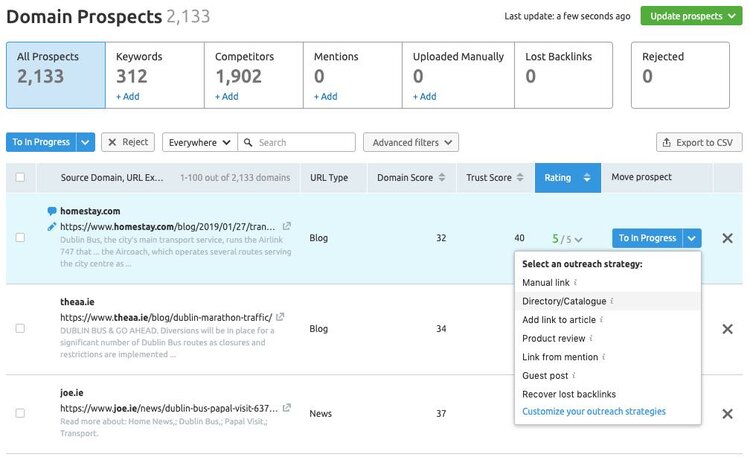
You can connect your yahoo, Gmail, etc to the link building tool and send your outreach email directly from the platform. This feature gives SEMrush a CRM-style feel for link building.
Moz doesn’t have any feature that compares to this. This feature gives SEMrush a significant edge over Moz Pro when it comes to backlink building.
Backlink audit
Both tools come with tools that would identify potentially toxic backlinks to your website. You can then compile these toxic links and upload them to Google to disavow them.
I prefer SEMrush’s approach to auditing these toxic links. In SEMrush, you can decide to whitelist a link you believe isn’t toxic. You then move the links you want to remove to a disavow list (stored on SEMrush) before exporting them to your file.

On Moz, you don’t have the option to choose which links you want to whitelist. You would have to export all the links first before organizing them in any spreadsheet application.
The only problem I have with both tools is that before you access the audit tool, you would have to create a ‘Project’ in SEMrush or a ‘Campaign’ in Moz. And there is also a limit to the number of these you can run at a time.
SEMrush vs Moz: Who wins this round?
The clear winner in this round is SEMrush. They offer an all-round backlink building tool that is better than Moz. While Moz is a great tool, the huge keyword and domain database from SEMrush along with the CRM style backlink outreach tool, makes it a better choice.
Keyword Research
In this category, we would compare both tools using their keyword research features.
| KEYWORD RESEARCH | SEMrush | Moz |
| Keyword database | 20 billion keywords (largest keyword database in the market) | No official report. But they offer 500 million suggestions in their keyword explorer tool |
| SERP Analysis | Yes | Yes |
| Search Engines |
SEMrush
SEMrush comes with a Keyword Overview tool that offers users a complete overview of the value of a keyword.
When you search for a keyword, you get metrics such as global volume, keyword difficulty, CPC, competition in paid search, results on SERP, SERP features, keyword trends, etc.

Along with these metrics, you also get access to keyword variations. This is very useful in helping users find related keywords they can rank for in the SERPs. This feature would help increase your visibility opportunities for alternative search queries.
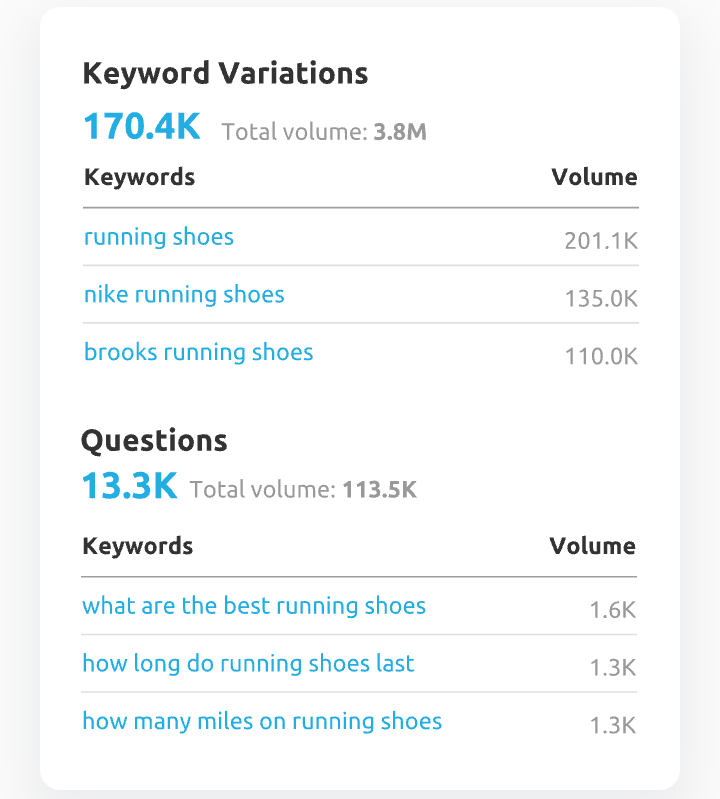
There is also a SERP analysis feature that gives you an idea of how the pages ranking for a particular keyword got there. You would be able to analyze the domain authority, the number of referring domains, backlinks, and estimated number of organic traffic of the ranking pages. These metrics would help you identify the amount of work you would have to put in to rank for those pages also.

SEMrush also comes with a Keyword Magic Tool that helps you find low-competition keywords you can rank for. The tool uses these metrics to help you find keywords:
- Competitive density:This would give you an idea of the level of competition between advertisers bidding for that particular keyword.
- Keyword difficulty:This metric would tell you how hard it would be to rank for that particular keyword.
- Search volume:This metric would show you the potential organic search traffic for that keyword
- SERP results:This metric shows the special search results triggered by that keyword.
SEMrush also offers another feature called Keyword Gap.The tool offers instant SEO competitive analysis between you and your competitors. You would be able to compare the keyword profile between you and up to 5 competitors. It would show you which keywords your competitors are ranking for and you are not.
SEMrush also offers a Keyword Managertool that allows you to create a list of keywords that you can refer to anytime. You can monitor the keyword difficulty of the keywords over time.
Moz Pro
Moz Pro comes with a Keyword explorer. This keyword research tool would help you identify which keywords people are searching for, the keywords you are already ranking for, and what it would take you to rank for keywords you are targeting.
To get started, type in the keyword or website you want to research in the keyword explorer tool.
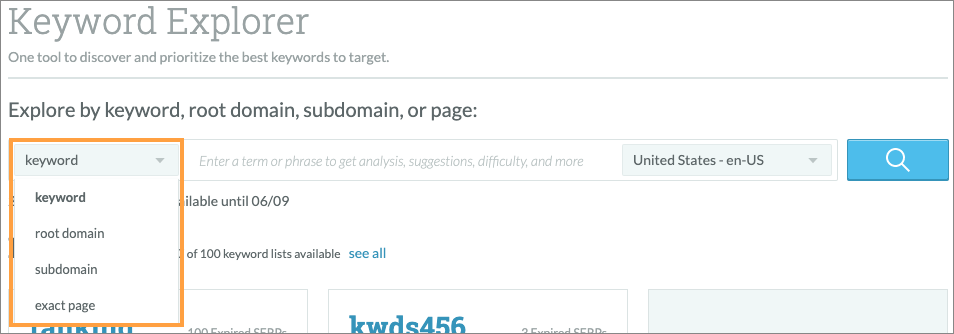
When you type a keyword in the search bar, you get a report on metrics such as monthly volume, keyword difficulty, organic click-through rate, and priority level.
There is also a keyword suggestion tab that gives you a list of related keywords that you can also rank for. The suggestions are ordered by relevance.
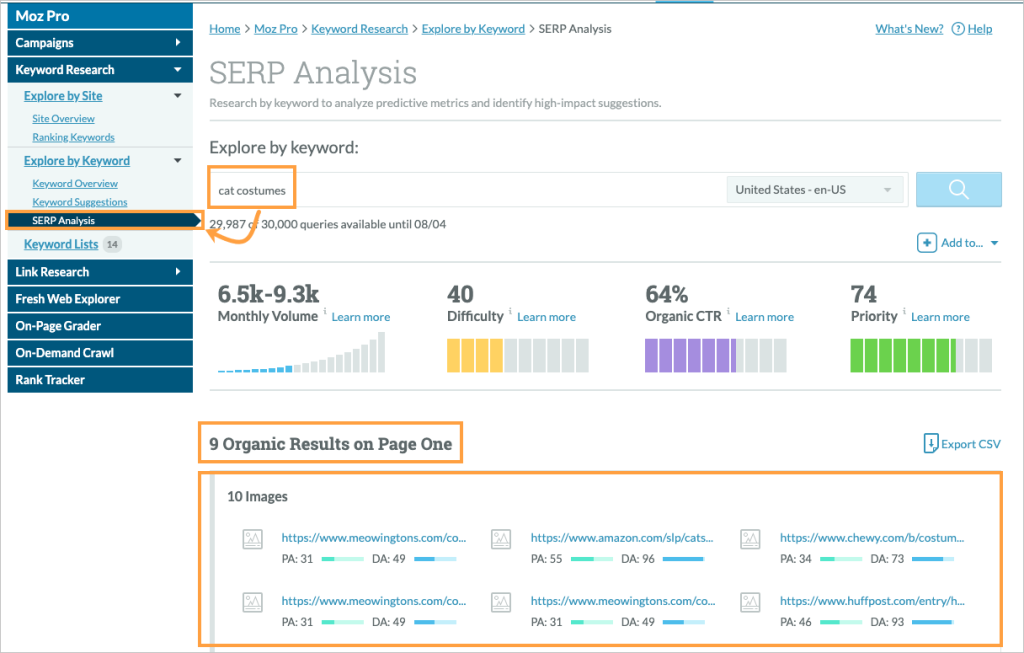
There is another feature called SERP analysisthat gives you insight into the top ranking domains for that keyword. You would get a preview of the page’s title, URL, page authority, and domain authority of the ranking websites.
You can also find keywords by the site. This is helpful when you are looking for keywords that you rank for. You’ll see a Site Overview Report with the keywords you are ranking for. You can also add additional websites that you want to compare.
Similar to SEMrush’s Keyword Manager tool, Moz also has a Keyword Listfeature that helps you create a list of keywords that you want to monitor over time.
Content Marketing Platform
This is the feature that SEMrush uses to trump any other SEO platform. SEMrush comes with a content marketing platform that combines creativity and analytics to help you improve each step of your content workflow. Moz doesn’t offer this feature.
| CONTENT | SEMrush | Moz |
| Ability to check the SEO potential of a piece of content | Yes (SEO writing assistant) | No |
| Ability to offer recommendations on how to create optimized content that ranks | Yes (SEO content template) | No |
| Ability to find out how well your website performs and what visitors think of your content | Yes (SEO content audit) | No |
| Ability to track the performance of a piece of content in terms of backlinks, keyword rankings, and social shares | Yes (Post tracking) | No |
| Ability to track mentions of your brand online | Yes (Brand monitoring tool) | Yes (Fresh web explorer) |
Here are some of the unique features that SEMrush offers to help you create better content.
SEO writing assistant
The SEO writing assistant reviews your content to see if your text follows the best SEO recommendations. You can get an add-on for both Google Docs and WordPress. As you type, your content is automatically checked for SEO-friendliness based on your target keywords.
SEO content template
The SEO content template helps you create amazing SEO-friendly content. The tool offers recommendations on how to create optimized content that ranks. They also analyze the content on Google’s top 10 ranking pages for your target keywords.
Content audit
SEMrush has a content audit (content analyzer) tool that helps you find out how well your website performs. It also gives you insight into what your website’s visitors think about your content. You can also connect your Google Analytics Account for more accurate data.
Post tracking
This is a useful feature that helps you track the performance of a piece of content in terms of backlinks, keyword rankings, and social shares. The data is updated on a daily basis. You can also compare articles and evaluate how they are performing.
Brand monitoring
SEMrush comes with a brand monitoring tool that helps you track you and competitor’s brand mentions online. The tool helps you to track mentions online, identify mention sentiment, analyze the authority of the mentioning resource, and also get mentions when you need them. With this feature, you would be able to assess your overall brand reputation and also find new partnership opportunities.
Moz also offers a fresh web explorertool that analyzes mentions of your brands, competitors, and keywords online. Moz also has a proprietary Feed Authority metric that lets you know which mentions are most important.
Traffic Analytics
In this category, we would compare both tools using their traffic analytics features.
SEMrush
SEMrush comes with a traffic analytics tool that gives you a complete view of your website’s online performance with traffic analysis.
Website traffic overview:SEMrush offers website traffic metrics like number of visits, unique visitors, user engagement metrics, source of traffic (direct, referral, social, and paid traffic), countries where your traffic is coming from, and traffic overview of your competition.
Audience insights:This traffic metric helps you see the websites your visitors go to. You can estimate the audience overlap for up to five competitors at once and also quantify your potential reach.
With SEMrush’s traffic analytics tool, you can also monitor the traffic journey of your visitors. You would be able to break down your competitor’s digital marketing strategies and analyze how they attract their website’s visitors. This would help you learn how their marketing mix evolved with historical data.
A useful feature that SEMrush offers is a bulk web traffic analysis tool. This feature would help you check the traffic data of up to 200 websites in one report.
Moz Pro
Moz Pro also comes with a traffic overview tool although it’s not as in-depth as SEMrush. On clicking the site traffic tab, you would see a traffic breakdown by search engines in a graph. You can adjust the scope of the data you want to review on a daily, weekly, or monthly basis.
The metric that you would examine includes visits, the percentage change in traffic count, percentage of total traffic, non-branded keyword visits, percentage of new visits, bounce rate, and pages per visit.
There is also a landing page tab where you can see the total traffic different landing pages received as well as the changes for whatever time period you’re reviewing.
SEMrush vs Moz: Who wins this round?
SEMrush wins this round. SEMrush comes with a ton of important metrics to help you analyze your website’s performance. The audience insights and competitor analysis feature on SEMrush gives it an edge over Moz. If you just want basic traffic metrics and to know which of your landing pages are generating the most traffic, then Moz does a good job at this.
SERP Tracking
Both SEMrush and Moz come with a feature that helps you track your rankings in the SERPs. The tool is called ‘Position tracking’ in SEMrush and ‘Rank tracking’ in Moz.
SEMrush position tracking overview
This tool allows you to track both your paid and organic search performance. There is a summary of your website’s visibility, the number of keywords you rank for, and most importantly – the average position of each keyword you are ranking for.
At the bottom of the report, you can also identify you and your competitor’s positions and manage the keywords in your campaign.
The report also shows the visibility trend of a domain, the estimated number of people that would visit a domain (estimated traffic), and an average position that shows the average of all your rankings for the keywords in your campaign.
SEMrush also comes with a position tracking cannibalization report. With this feature, you can analyze your cannibalization health.
Keyword cannibalization is when two or more pages on your website are targeting the same keyword. As a result of this, the pages would be competing against each other in the search results and might end up losing their positions. The position cannibalization report helps you avoid this problem.
Moz rank tracking overview
Moz rank tracking overview tool gives you a full overview of your Search Visibility, Keywords Rankings, and movement within certain position brackets.
You would be able to track the movement of your keywords in position ranges of #1-3, #4-10, #11-20, or #21-50 in the SERP. The overall ranking would show you the number of your keywords that have moved up or down the SERPs.
There is also a search visibility chartthat shows the estimated percentage of clicks your website should receive based on your rankings in the SERPs.
You can also track your ranking across four different search engines (Google en-US, Yahoo en-AU, Google en-GB, and Google Mobile en-US).
There is also a competition tabthat shows where your site ranks and where each of your competitors rank. In the search visibility graph, you can also see your visibility in the graph vs your competitor’s visibility.
There is an opportunity tab where you’ll find keywords that may be sending traffic to your site that you’re not tracking.
SEMrush vs Moz: Who wins this round?
Both tools offer amazing features for tracking your ranking on the SERPs. But SEMrush wins this round. I would go for SEMrush because of the position tracking cannibalization report. SEMrush Rank Tracking also updates positions and mobile data every day for all their users by default. These features give SEMrush an advantage over Moz.
Site Audit
Both SEMrush and Moz come with a site audit feature to help you evaluate your site’s performance in terms of on-page SEO and technical SEO.
Both tools look for issues on your site that might be negatively affecting its performance. Some of these negative factors include duplicate content, crawl errors, overuse of keywords, missing meta-tags, and missing headings.
SEMrush
SEMrush’s audit tool would help you check your website’s health and also offer recommendations on how to fix all the issues on your site.
You can perform a full SEO audit where you inspect several factors that affect the performance and ranking of your site. These factors include website speed, loading speed, content issues, crawlability, Meta tags, HTTP security protocol, AMP implementation, internal linking, etc.

The tool scans your entire website for 130+ checks related to any issue that may damage your website’s health. There are also automated reports that keep a 24/7 eye on all the technical issues and changes of your website.
(Check out this article on website speed optimization tips to reduce load times)
Moz Pro
Moz also has a site crawl feature that keeps track of new and recurring issues that might affect your website’s performance. The tool comes with colorful charts showing the breakdown of issue categories, new issues, and total issues; allowing you to discover trends and opportunities that you can use in improving your SEO performance.
While both tools offer useful suggestions to help improve your website performance, SEMrush is much easier to use. With Moz, you would have to flick between different sections in the navigation to get all the info you need.
Moz also comes with a useful feature called page grader that allows you to enter in a page’s URL and a keyword and see a list of suggestions to help you improve the SEO performance of that page.
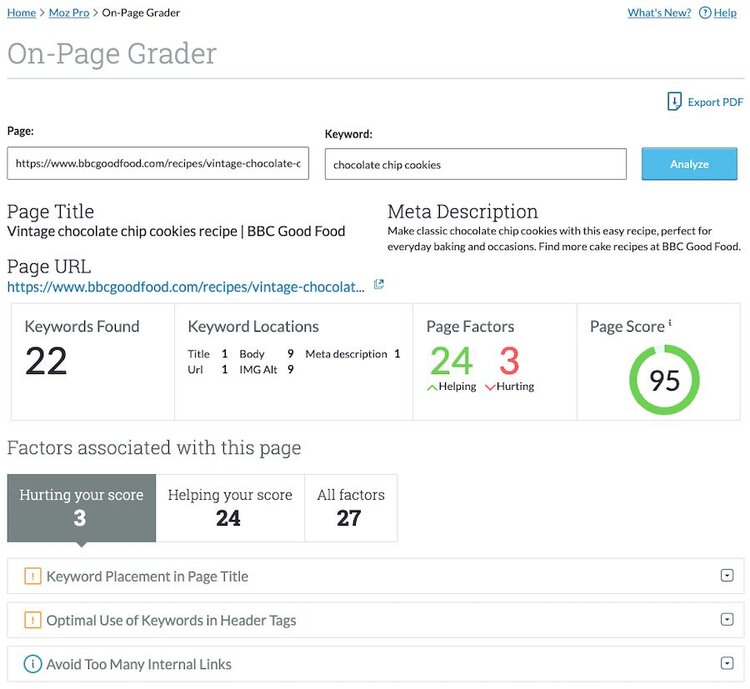
SEMrush however offers a better feature called on-page SEO checker. Instead of just analyzing a single page as seen in Moz’s page grader, SEMrush goes through the entire website and offers actionable strategies you can use in improving each page.
While both tools are great for auditing a website, I prefer SEMrush because you get to see all of your data in one place. This would give you a quicker understanding of the changes you need to make.
Broken link building
Broken link building is a creative way to look for backlinking opportunities.
This strategy involves looking for broken links (i.e web pages that no longer exist), recreating the dead content, and asking anybody that used to link to the dead content to link to your own content instead.
With this strategy, you would be able to build more backlinks to your website and increase your ranking and visibility in search engines.
Both SEMrush and Moz offer features for broken link building. However, performing broken link building on Moz is more difficult than SEMrush.
To run a broken link building campaign on Moz, you would have to do the following:
- First, create a campaign for the site you want to examine for broken links
- Go through a list of status codes (the status code for broken links is 404)
- Export all the data for broken links to a spreadsheet
- Search for the site owners that linked to the dead links and then send your outreach email from your email marketing tool.
Compared to SEMrush, after you have created your campaign (or project as it is called on SEMrush), you would perform a full website audit of your competitor’s website to find their dead pages.
Once you have gotten this data, you can move the broken links to an outreach list in SEMrush and use the SEMrush CRM-style outreach tool to conduct a broken link outreach directly from the platform. You wouldn’t have to export the list to a spreadsheet or use an external email client.
So, SEMrush definitely wins this round because of its ease of use.
Interface and ease of use
Of the two tools, SEMrush is the easiest to use. SEMrush lays out its dashboard in such a way that you can see all information with a quick glance. If you also prefer to see your data visually, SEMrush is the tool of choice.
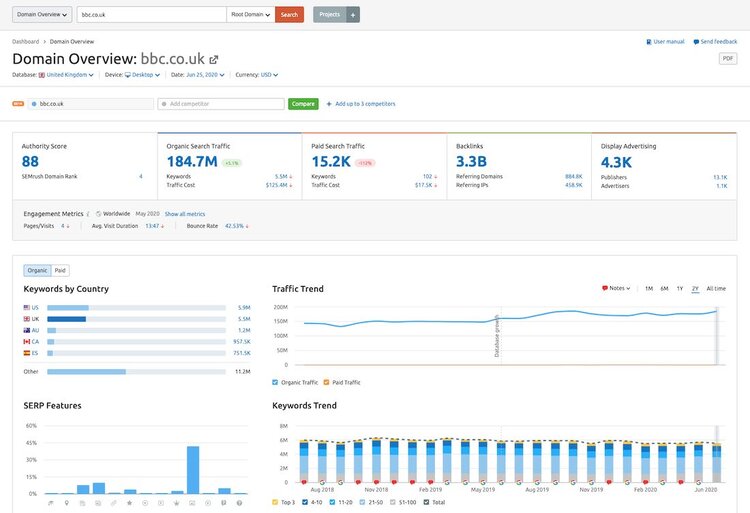
With Moz, most of the time you would have to dig deeper into the navigation tab and flick between reports to see the data you need. I am not saying that Moz is difficult to use, it’s not just as intuitive as SEMrush.
The ease of doing broken link building on SEMrush is also a bonus. If you prefer SEMrush’s CRM style approach to broken link building outreach than exporting your list to a spreadsheet and using an external email client – then SEMrush is the option you should go for.
PPC
SEMrush comes with a PPC keyword tool while Moz doesn’t.
SEMrush PPC keyword tool offers advertisers an easy way to plan and set up an optimized Google Ads campaign. With the PPC keyword tool, you can find the best keywords based on CPC, volume, and other vital metrics. This would help you build a perfect keyword list, set negative keywords, and remove duplicates.
SEMrush also includes detailed CPC competition and distribution data, live ads, and PPC campaign planning tools.
Pricing
SEMrush has 4 pricing plans:
- Pro: $99.95 per month
- Guru: $199.95 per month
- Business: $399.95 per month
- Enterprise: negotiable
You would also get a 16% discount if you pay upfront for a year. They also offer a free 7-day trial you can use to test out the platform.
Moz has 5 pricing plans:
- Standard: $99 per month
- Medium: $149 per month
- Large: $249 per month
- Premium: $599 per month
- Enterprise: negotiable
You would also get a 20% discount if you pay upfront for a year. They also offer a generous free 30-day trial you can use to test out the platform.
Reports per day
SEMrush is very generous with the number of reports you can create in a day. On their entry-level plan, you can pull 3,000 domain analysis reports per day
Moz however is not as generous as SEMrush. They allow you to run only 150 keyword queries or 5000 backlink queries.
Number of users
SEMrush allows you to have only one account user in their default plan. For additional users, you would have to pay $70 per month per ‘Pro’ user or $100 per month per ‘Guru’ or ‘Business’ user. You can’t also add more than 2 users per plan. Only the business plan allows you to add up to 9 users.
Moz in this regard is more generous than SEMrush. While their two cheapest plans allow only one user, the ‘Medium’ and ‘Large’ plan allows 3 and 5 users respectively. For additional users, you would have to pay $49 per user irrespective of the plan. I don’t think they have a limit on the number of users you can add also.
Support
From what’s on their respective websites, SEMrush wins this round. SEMrush comes with three channels of support: phone, chat, and email. Moz offers only one channel for support – email.
SEMrush vs Moz Summary: Which is the best SEO tool?
While both of them are great tools, I have to choose SEMrush as the best. When it comes to ease of use, SEMrush is much better than Moz. SEMrush also comes with more additional features than Moz.
As a content marketer, I love their content marketing platform a lot. The ability to optimize my content to rank for my target keywords is a bonus for me. The CRM style management tool for link building is also great. It helps increase my productivity since I don’t have to jump from one business tool to another (I can do my link building outreach directly from the platform).
There are a ton of SEO tools like Moz, but my best is SEMrush. I have written another comparison of SEMrush Vs Ahrefs Vs Moz Vs SpyFu. Do check it out.
Thanks for reading.
Which of these tools do you use and why? I would love to read your inputs.
